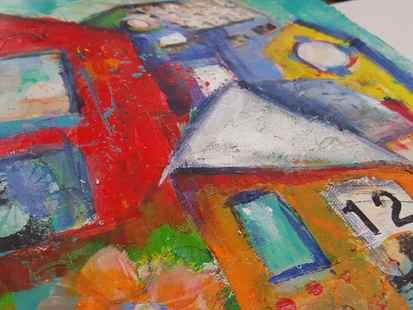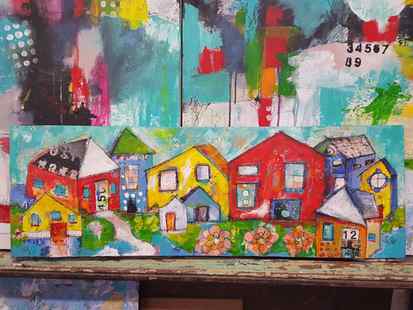Don’t Like Your Painting? Here’s How to Fix It | Mixed-Media Art Advice
Editor’s note: When you’ve been teaching mixed-media art workshops for years like Jodi Ohl has, you come to hear some of the same questions from students, regardless of the location. Jodi, who travels the country sharing her knowledge in classes, is also a guest blogger with Cloth Paper Scissors, and today’s post features her second blog about student FAQs.
Jodi now has four mixed-media art workshops available on DVD, and lucky for you, they’re included in Interweave’s “3 DVDs for only $40” sale. Get your order in today before the sale ends, and take in Jodi’s advice on how to get through the most difficult stages of creating a painting. Don’t worry, friends, we’ve all been there! Lucky for us, we have experts like Jodi to inspire us to keep going. ~Cherie

FAQ: I Don’t Like My Painting. What Can I Do to Fix It? by Jodi Ohl
Over the last eight or nine years that I’ve been around the country working with mixed-media artists in the classroom, I’ve learned to anticipate this question, which arises several times during a workshop: “I don’t like my painting. What can I do to fix it?” There are times when a student will voice this out loud with a sigh of frustration (or worse), and at other times it’s whispered internally as the artist’s inner critic puts up a wall of doubt. The truth of the matter is that almost every artist experiences a struggle when working on their craft.
Painting is much like a relationship, in that we go through the initial exciting “dating stage” as we get started on this new journey. As artists, we’re full of anticipation about what is to come and are hopeful that it will turn out exactly as we desire. At some point in the relationship between artist and canvas we begin to doubt this is ever going to work. The interaction becomes messy. The journey takes twists and turns we hadn’t anticipated, and we’re not sure we like how it’s going.
Some artists stay loyal to the relationship and forge through the hard parts, while others take a much-needed break. Perhaps time and space will clear our heads, or at least give us a new direction to pursue. There will be moments when we start to fall back in love with our work. One simple change can act as a compromise to allow the flow to return to our dialogue. We understand each other once again. Just as quickly, it can fall apart. We’ve done something that disrupts the flow. We’ve inadvertently created tension in a place it didn’t belong. The future isn’t quite clear, until it is again.

Like a puzzle, a painting is hard to envision when the pieces aren’t fully put together. Clarity may not fully come until the work is nearly finished, and even at that point it may take more time to find. If you’re steadfast and stay in the relationship, you’ll realize that, while your doubt was somewhat justified in the middle, you simply weren’t finished. It was a work in progress, which can be unsettling.
As silly as this metaphor may seem, it really depicts how most artists feel while creating. The road to the end is not a linear path. There are many bumps, twists, turns, changes, and do-overs that may happen along the way. As an artist, only YOU can truly decide what your work needs. It may indeed need some fixing, but what I see isn’t necessarily what YOU think is missing or wrong.

Before throwing in the towel on your mixed-media art, consider these points. Keep in mind that this is just a small sampling of what you can do or ask yourself. I don’t think there’s a cookie-cutter solution for any artist but there certainly are some basic things you can consider when looking for ways to improve your art.
• Eliminate the words “hate” and “dislike” from your vocabulary. Voicing negativity gives power to your inner critic. Instead, believe you have what it takes to work through the rough spots without giving up or giving power to negativity.
• Take pictures of your work. It’s amazing what you may see through the lens that you can change to get you back on track.
• When in doubt, review a few of the main culprits that can derail a painting. Do you have enough values showcased, or ample contrast among colors, patterns, and/or shapes of your featured elements? If your work is lacking any of these components, you may find that addressing these design elements is a good place to start.
• Is the painting balanced or purposely imbalanced, symmetrical or asymmetrical? Is this what you intended? If not, take action to re-work your art to get it to the place you envisioned. Be flexible. Sometimes our initial visions can be enhanced by making even subtle changes. Trust your instincts.
• Use the right brushes for the job you’re doing. It’s amazing how many times artists will get frustrated because of less-than-ideal brush strokes, errant lines in their work, or the inability to create details. Evaluate the tools you’re using and make adjustments. Don’t use a large brush to do small work or a small brush to cover a large area. Start with your biggest brush first and work your way down to the smallest brush as you finish your painting. Likewise, use both round and flat brushes to blend or create sharp edges, respectively.
• Take a break and walk away for a bit. Don’t rush. Despite what many believe, painting is not a race to the finish line. It’s a journey.
• Turn your painting around several times as you work. By gaining a new perspective, you may find areas that could be enhanced.
• Lastly, keep practicing. You’ll gain confidence in knowing how to fix or finish your work the more you do the work. Remember, you have to work at the “relationship” to make it successful.
For more words of wisdom and advice for working through the rough spots so you can complete paintings from start to finish, check out one or more of my four new mixed-media art DVDs through Interweave! ~Jodi
Learn new mixed-media art techniques in this free eBook when you join our newsletter for daily tips, special offers, and more!
How to Start Over on an Oil Painting

We’ve all created at least one painting we don’t like. Many of us have created hundreds of paintings we don’t like. Sometimes one painting will stare at you and taunt you. It’ll call you names and maybe even make you want to cry. “Should I burn it?” we ask ourselves. Then that other voice tells us it’s a perfectly good canvas. I’m writing this article for those of you who listened to that voice and realize you can reuse a canvas, but don’t know how to go about starting over on an oil painting. Most of the time you can just paint over it with acrylics and it’s back to a blank canvas. But what if it’s an oil painting?
You can’t just cover up an oil painting with acrylic, modeling paste or gesso. Those materials won’t stick, they’ll eventually will peel off because oil is long lasting and much more resilient. So if you want a fresh start to your oil painting, there’s one way to do it. The only substance that can go over oil paint, is more oil paint. After your “ugly messed up” painting is completely dry, create a mixture of half white oil paint and half Galkyd medium or another fast drying medium (liquin, liquin gel, cold wax, cozica). You can also use black oil paint instead of white, if that works better with your process. Using a big bristle brush or catalyst tool (rubber spreading tool), paint over the whole surface of your oil painting. You can also leave some of the outer edges or parts of your painting still showing.
Before covering up your painting, I recommend taking the time to really study your painting and figure out what exactly makes it a bad painting. Ask your friends and family why they don’t like it and don’t be offended if they are candid, it’s better to receive useful advice than brown-nosing (in all areas of your life). Once you’ve narrowed in on what it is that disturbs you and others about the painting, try and imagine the painting without that. Does the painting work? Is there anything you like about it?
Once you’ve covered what you want to cover, think of your painting in a new way, think positive thoughts. It began as something else and you’ll transform it into something new and beautiful. Not all paintings you hate are lost causes, many times you can push through the resistance and complete the painting anyways. It can be a masterpiece in the end. But other times, starting over is a way to overcome the resistance as long as you see it through to completion. Always try to finish your paintings. When you do, you’ll feel a sense of accomplishment and will learn a tremendous amount with each painting you finish.
Don’t let starting over on an oil painting ever scare you again. You have what it takes to create beautiful art, you just have to keep at it. Here at Milan Art Institute, we believe in you and will help you every step of the way, just ask. Thank you for reading and happy creating! If you started over on an oil painting after reading this article tag me and Milan Art Institute on instagram so we can see!
Co-owner of Milan Art Institute & Professional Artist





